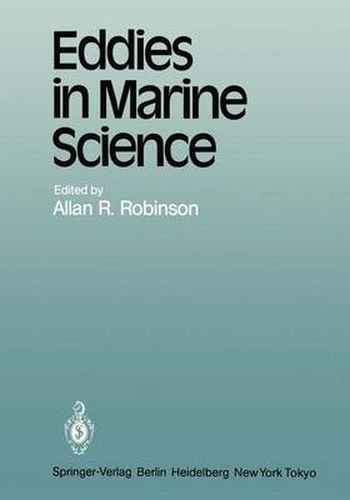Readings Newsletter
Become a Readings Member to make your shopping experience even easier.
Sign in or sign up for free!
You’re not far away from qualifying for FREE standard shipping within Australia
You’ve qualified for FREE standard shipping within Australia
The cart is loading…






This title is printed to order. This book may have been self-published. If so, we cannot guarantee the quality of the content. In the main most books will have gone through the editing process however some may not. We therefore suggest that you be aware of this before ordering this book. If in doubt check either the author or publisher’s details as we are unable to accept any returns unless they are faulty. Please contact us if you have any questions.
It is now well known that the mid-ocean flow is almost everywhere domi nated by so-called synoptic or meso-scale eddies, rotating about nearly vertical axes and extending throughout the water column. A typical mid ocean horizontal scale is 100 km and a time scale is 100 days: these meso scale eddies have swirl speeds of order 10 cm s -1 which are usually con siderably greater than the long-term average flow. Many types of eddies with somewhat different scales and characteristics have been identified. The existence of such eddies was suspected by navigators more than a century ago and confirmed by the world of C. O’D. Iselin and V. B. Stock man in the 1930’s. Measurements from RIV Aries in 1959/60, using the then newly developed neutrally buoyant floats, indicated the main char acteristics of the eddies in the deep ocean of the NW Atlantic while a se ries of Soviet moored current-meter arrays culminated, in POLYGON- 1970, in the explicit mapping of an energetic anticyclonic eddy in the tropical NE Atlantic. In 1973 a large collaborative (mainly U. S. , U. K. ) program, MODE-I, produced synoptic charts for an area of the NW At lantic and confirmed the existence of an open ocean eddy field and es tablished its characteristics. Meso-scale eddies are now known to be of interest and importance to marine chemists and biologists as well as to physical oceanographers and meteorologists.
$9.00 standard shipping within Australia
FREE standard shipping within Australia for orders over $100.00
Express & International shipping calculated at checkout
This title is printed to order. This book may have been self-published. If so, we cannot guarantee the quality of the content. In the main most books will have gone through the editing process however some may not. We therefore suggest that you be aware of this before ordering this book. If in doubt check either the author or publisher’s details as we are unable to accept any returns unless they are faulty. Please contact us if you have any questions.
It is now well known that the mid-ocean flow is almost everywhere domi nated by so-called synoptic or meso-scale eddies, rotating about nearly vertical axes and extending throughout the water column. A typical mid ocean horizontal scale is 100 km and a time scale is 100 days: these meso scale eddies have swirl speeds of order 10 cm s -1 which are usually con siderably greater than the long-term average flow. Many types of eddies with somewhat different scales and characteristics have been identified. The existence of such eddies was suspected by navigators more than a century ago and confirmed by the world of C. O’D. Iselin and V. B. Stock man in the 1930’s. Measurements from RIV Aries in 1959/60, using the then newly developed neutrally buoyant floats, indicated the main char acteristics of the eddies in the deep ocean of the NW Atlantic while a se ries of Soviet moored current-meter arrays culminated, in POLYGON- 1970, in the explicit mapping of an energetic anticyclonic eddy in the tropical NE Atlantic. In 1973 a large collaborative (mainly U. S. , U. K. ) program, MODE-I, produced synoptic charts for an area of the NW At lantic and confirmed the existence of an open ocean eddy field and es tablished its characteristics. Meso-scale eddies are now known to be of interest and importance to marine chemists and biologists as well as to physical oceanographers and meteorologists.